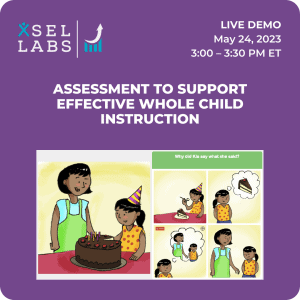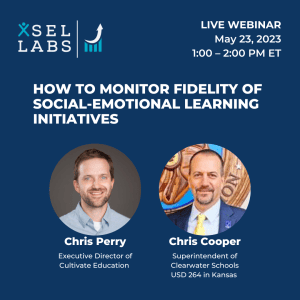People often have very strong opinions about student assessment, particularly when it comes to social and emotional learning assessment. This is especially true when discussing the use of SEL assessment for screening. One colleague is adamant that SEL assessment should never, ever, under any circumstances be used for screening. His fear, as I understand it, is that students will be labelled, categorized, and stigmatized.
I understand this concern, and, to a point, I share it. But a blanket prohibition on any particular use of an assessment is, in my view, unwise. The more prudent approach is to be clear about what you mean by “screen” and make sure you understand the benefits and risks, and do everything you can to maximize benefit and mitigate risk.
In my conversations with colleagues in the education community, I’ve come to understand that single word “screening” is used to mean two very different things—screening as a method of identification and screening as a way to understand student strengths and needs to inform differentiated instruction.
SEL Screening for Identification
Sometimes educators use “screening” to refer to the practice of administering a brief and economical assessment designed to identify people who are likely to have a diagnosable condition. Think mammograms to identify breast cancer. The mammogram does not diagnose the condition, but it identifies the subset of women who need diagnostic testing because something looked fishy on their exam.
In the case of SEL assessment, this would mean administering an SEL assessment, and classifying students who score above or below a cutoff score as being “at-risk” of some condition—say EBD—then following up with diagnostic testing to confirm or disconfirm their diagnostic status and eligibility for special education.
This is the kind of screening that my colleague and I agree is, with a couple of noteworthy exceptions, risky. Why? Few SEL assessments have been validated for this kind of screening. As a result, using SEL assessment for identification can be misleading. And there is a risk that screeners will be used to categorize students in ways that lead to inappropriate educational placements.
(Note please that screening is an important function of assessment and can be done appropriately and beneficially. There are even one or two SEL screeners out there that seem to do a good job. Still, under most circumstances, the risk-benefit ratio of using SEL assessment to screen for identification is not very good.)
Fortunately, this is rarely what educators mean when they refer to screening.
SEL Screening for Differentiation
Usually, educators use “screening” to refer to assessing student strengths and needs so that teachers can differentiate instruction and teach students in their optimal teaching range. Imagine a reading assessment that a teacher uses to understand student skill level so she can tailor reading instruction to the level of the student—challenging enough to promote growth; not so challenging as to frustrate.
In the case of SEL assessment, this would mean administering an SEL assessment, and using data about individuals or groups to clarify student social-emotional strengths and needs and tailor SEL instruction accordingly. This kind of screening is a lot like formative assessment to improve teaching and learning.
This is what educators almost always mean when they refer to screening. And this form of screening, thought not risk-free, has a more favorable risk-benefit ratio than the other form.
xSEL Labs offers Social and Emotional Learning (SEL) Assessments that can help with this kind of screening.
Benefits and Risks of SEL Screening for Differentiation
If you want to use an SEL assessment to screen in this way, it is good to understand the benefits and risks.
The benefits of this kind of screening are fairly clear. Teachers will understand their students better. They can use what they learn about students to be more effective teachers. Students will receive the level of instructional rigor that is best for their skill level.
There are also risks. No assessment is perfect. We know that teacher expectations can influence student development. An errant score on an imperfect test might lead a teacher to an erroneous conclusion about a student, and lead her down a path of lowered expectations leading to a self-fulfilling prophecy.
The potential benefits are real. So are the risks. So what should you do?
Maximizing Benefit, Mitigating Risk of SEL Screening
There are steps to be taken that can maximize the benefit of SEL screening for differentiation while mitigating the risk.
Don’t treat SEL assessment as a one-and-done phenomenon. Assessment should inform instruction, and continually collecting assessment data about students will minimize the risk that a single score or test performance will lead to an incorrect and harmful teacher expectation.
- Treat SEL assessments like Ronald Reagan treated the USSR—trust, but verify. If you have one piece of data that suggests students are struggling in an area that might merit some attention, look to other evidence that either supports or disconfirms that impression.
- Treat assessment results as the source of questions as much as answers. When you see a pattern in the data and you have an idea about what it means, treat this idea as a hypothesis that you will test experimentally through instruction and further data collection. This mindset prevents test interpreters from reducing a person to a set of imperfect scores.
- If you are going to differentiate instruction by grouping for instruction, make sure that the groupings are time-limited, and subjected to repeated assessment to ensure that students are receiving the right level of instruction for them.
- Better yet, create mixed-level ability groups and cooperative learning strategies. In academic subjects, this approach benefits weaker students and does not prevent stronger students from advancing. My guess is it would do the same for social and emotional skill development.
Should You Use SEL Assessment to Screen?
That’s up to you. Please don’t give students an SEL assessment, categorize low performers, and use that categorization to place them in an inappropriate instructional setting. But if you want to use SEL assessment to differentiate instruction, I recommend being clear about your purpose, being mindful of the benefits and risks, and taking active steps to maximize benefit and mitigate risk. If you do these things, SEL assessment data can be an essential tool to improve teaching and learning.
Contact xSEL Labs to learn more about Social Emotional Learning (SEL) Assessments to meet your screening and other goals.



